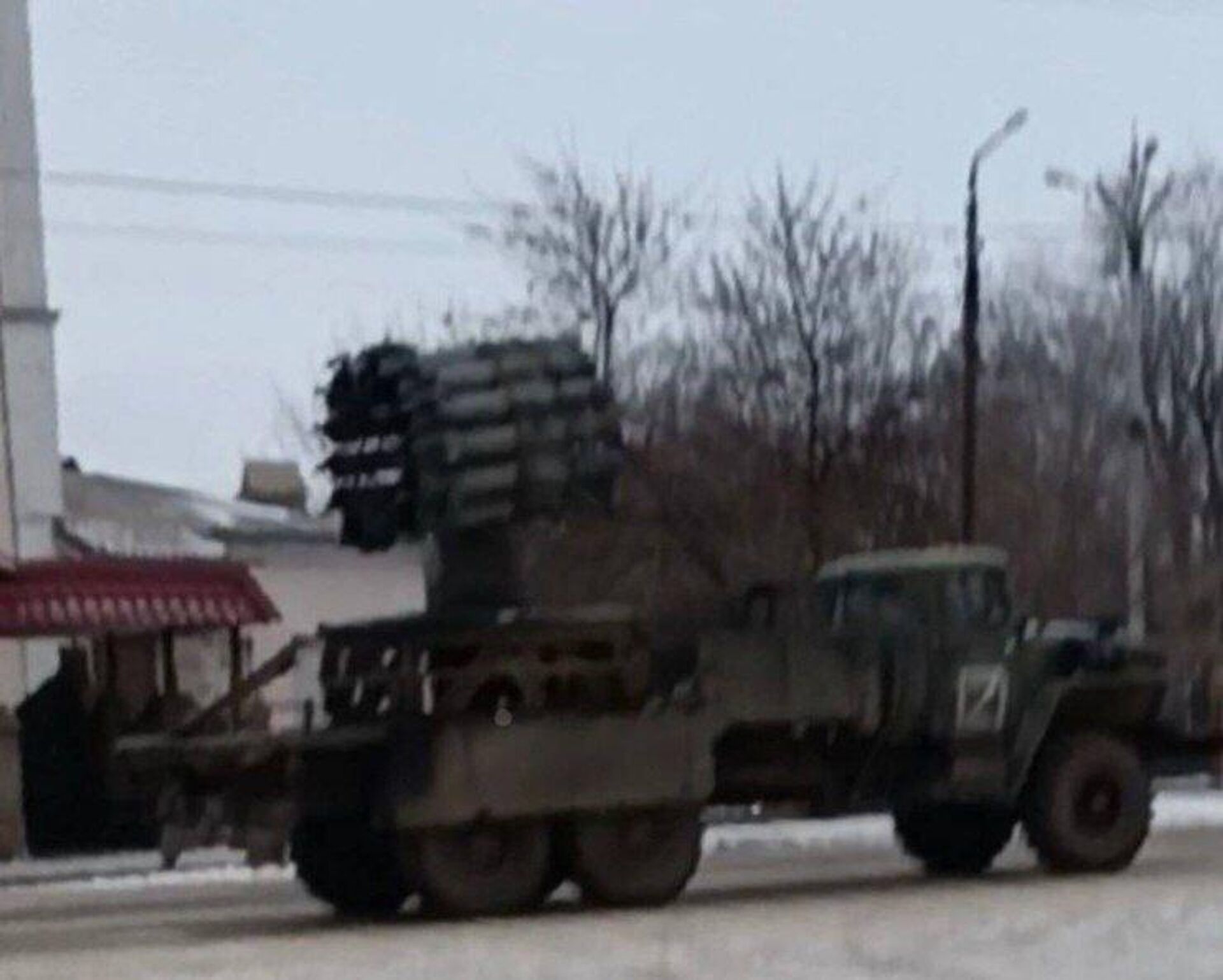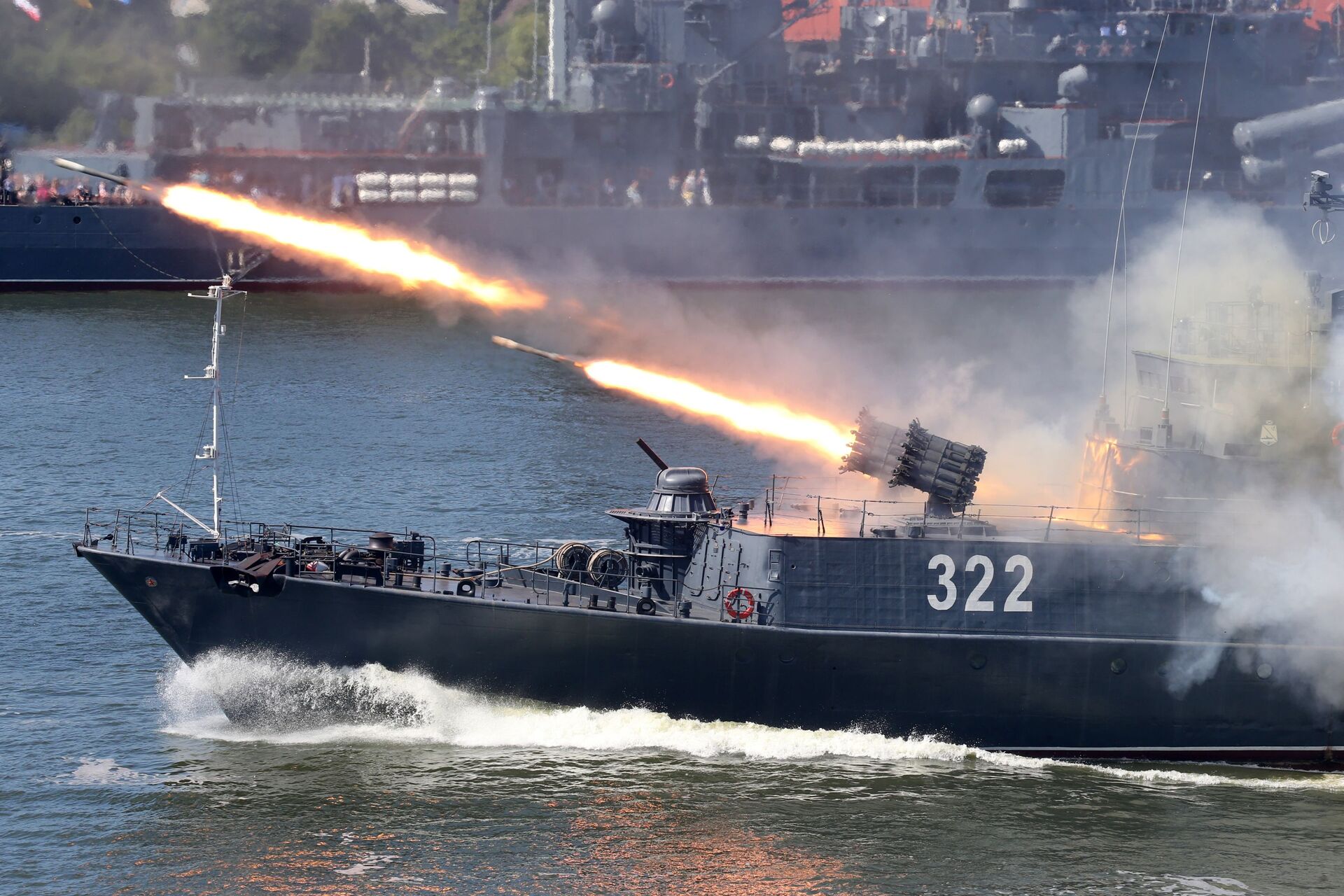https://sputnikglobe.com/20240125/how-russia-transformed-t-80-tank-into-armored-multiple-rocket-launcher-1116382779.html
How Russia Transformed T-80 Tank Into Armored Multiple Rocket Launcher
How Russia Transformed T-80 Tank Into Armored Multiple Rocket Launcher
Sputnik International
The Ukrainian crisis has demonstrated that far from being a holdover of 20th century warfare, artillery remains an indispensable ‘God of War’ in 21st century... 25.01.2024, Sputnik International
2024-01-25T14:25+0000
2024-01-25T14:25+0000
2024-01-25T14:25+0000
military
t-80
navy
russia
military & intelligence
ukraine
multiple-launch rocket systems (mlrs)
rpk-8
https://cdn1.img.sputnikglobe.com/img/07e8/01/19/1116376760_171:0:1074:508_1920x0_80_0_0_83e03af48dd44a1ba3474e129102977f.png
Footage has appeared online showing an RBU-6000 naval rocket launcher mated to a T-80B tank chassis being fired in a steppe somewhere on the frontline in the special operation zone.Russia’s military and arms industry have not commented on the curious, custom-built multiple launch rocket system (MLRS), with RBU-6000 launchers attached to ground vehicles first spotted in the fall of 2023, and fitted aboard MT-LB tracked armored fighting vehicles, as well as Ural and Kamaz trucks.The decision to attach the RBU-6000 to a T-80 chassis seems to have been the next logical step, given that tank armor will provide its crew with protection against everything from enemy small arms fire to artillery shrapnel, nullifying a key vulnerability of more traditional MLRS launchers and allowing it to be placed closer to dangerous frontline areas.What is the RBU-6000?Introduced with the Soviet Navy back in the early 1960s, the RBU-6000 is 3.5 ton, 213 mm caliber anti-submarine and anti-torpedo rocket launcher with twelve radially placed barrels typically attached to surface warships. Also known as the ‘Smerch-2’ (lit. ‘Tornado-2’ or ‘Whirlwind-2’), the system fires RGB-60 rockets - which weigh 113.5 kg apiece, come with a 23 kg high-explosive munition, have a range of up to 6 km, and function at depths up to 500 meters.A deep modernization of the RBU-6000 known as the RPK-8 was developed in the 1980s and adopted into service in late 1991, featuring new rockets with underwater homing capability and a functional operational depth of up to 1,000 meters. The newer systems were equipped with 19.5 kg shaped charges designed to attach themselves to enemy subs and tear open their hulls. The latest variants of the installation come with a remotely directed fire control system.Russian warships taking part in the special military operation have used both the RBU-6000 and the RPK-8 extensively to target Ukrainian naval drones attacking ships of Russia’s Black Sea Fleet and their home ports.What are the Characteristics of the T-80’s Chassis?First introduced into service in the mid-1970s, the T-80 tank chassis features a powerful, 1,100 horsepower gas turbine engine, presumably giving the customized RBU-6000-equipped MLRS module enough pep to maneuver into the line of fire, shoot its rockets and rapidly fall back to avoid enemy counter fire in a strategy known as ‘shoot and scoot’.At the start of the special military operation in 2022, Russia had thousands of mothballed T-80s in various states at warehouses scattered across the country, with arms makers gradually taking them out, dusting them off, and modernizing them, and sending them to the front. The T-80B variant seen in the video above was introduced in 1980, and typically comes equipped with improved composite armor, a laser rangefinder, improved fire control system and night sight. It’s not clear which of these improvements are featured in the new Smerch-2-equipped T-80-based MLRS.Russia’s propensity for using tank chassis for purposes other than a modern main battle tank is well-known, with Soviet and Russian engineers mating them to heavy engineering and mine-clearing equipment, attaching them to heavy guns to create mobile howitzers, using them to propel the deadly TOS-2 thermobaric heavy flamethrower system, and even attaching them to the unique 1K17 Szhatie (lit. ‘Compression’) – a Soviet laser combat platform designed to disable enemy optical-electronic equipment.What are the Ground-based Smerch-2's Capabilities?The T-80 chassis-fitted ground-based Smerch-2 launcher appears to be the brainchild of frontline military engineers, known to create a wide array of do-it-yourself-style arms using whatever tools, equipment and spare parts happen to be available. The system's appearance in a variety of form factors (attached to a T-80 chassis, MT-LB APCs and trucks) appears to confirm its operational effectiveness. No official details on the system's capabilities have been publicized, but if it's anything like its naval variant, the ground-based Smerch-2 would have a range up to 6 km, while the T-80 chassis mean an operational range of up to 335 km without refueling.
russia
ukraine
Sputnik International
feedback@sputniknews.com
+74956456601
MIA „Rossiya Segodnya“
2024
News
en_EN
Sputnik International
feedback@sputniknews.com
+74956456601
MIA „Rossiya Segodnya“
T80 tank enhanced
Sputnik International
T80 tank enhanced
2024-01-25T14:25+0000
true
PT0M58S
Sputnik International
feedback@sputniknews.com
+74956456601
MIA „Rossiya Segodnya“
what is the ground-based smerch-2, what is t-80 chassis based artillery
what is the ground-based smerch-2, what is t-80 chassis based artillery
How Russia Transformed T-80 Tank Into Armored Multiple Rocket Launcher
The Ukrainian crisis has demonstrated that far from being a holdover of 20th century warfare, artillery remains an indispensable ‘God of War’ in 21st century conflicts. Russia has a vast array of artillery types in its arsenal, with its latest entry consisting of a T-80 tank chassis fitted with a naval rocket launcher. Here’s what we know about it.
Footage has appeared online showing an RBU-6000 naval rocket launcher mated to a T-80B tank chassis being fired in a steppe somewhere on the frontline in the special operation zone.
Russia’s military and arms industry have not commented on the curious, custom-built multiple launch rocket system (MLRS), with RBU-6000 launchers attached to ground vehicles first spotted in the fall of 2023, and
fitted aboard MT-LB tracked armored fighting vehicles,
as well as Ural and Kamaz trucks.
The decision to attach the RBU-6000 to a T-80 chassis seems to have been the next logical step, given that tank armor will provide its crew with protection against everything from enemy small arms fire to artillery shrapnel, nullifying
a key vulnerability of more traditional MLRS launchers and allowing it to be placed closer to dangerous frontline areas.
Introduced with the Soviet Navy back in the early 1960s, the RBU-6000 is 3.5 ton, 213 mm caliber anti-submarine and anti-torpedo rocket launcher with twelve radially placed barrels typically attached to surface warships. Also known as the ‘Smerch-2’ (lit. ‘Tornado-2’ or ‘Whirlwind-2’), the system fires RGB-60 rockets - which weigh 113.5 kg apiece, come with a 23 kg high-explosive munition, have a range of up to 6 km, and function at depths up to 500 meters.
A deep modernization of the RBU-6000 known as the RPK-8 was developed in the 1980s and adopted into service in late 1991, featuring new rockets with underwater homing capability and a functional operational depth of up to 1,000 meters. The newer systems were equipped with 19.5 kg shaped charges designed to attach themselves to enemy subs and tear open their hulls. The latest variants of the installation
come with a remotely directed fire control system.
Russian warships taking part in the special military operation have used both the RBU-6000 and the RPK-8 extensively to target Ukrainian naval drones attacking ships of Russia’s Black Sea Fleet and their home ports.
What are the Characteristics of the T-80’s Chassis?
First introduced into service in the mid-1970s, the T-80 tank chassis features a powerful, 1,100 horsepower gas turbine engine, presumably giving the customized RBU-6000-equipped MLRS module enough pep to maneuver into the line of fire, shoot its rockets and rapidly fall back to avoid enemy counter fire in a strategy known as ‘shoot and scoot’.
At the start of the special military operation in 2022, Russia had thousands of mothballed T-80s in various states at warehouses scattered across the country, with arms makers gradually taking them out, dusting them off, and modernizing them, and sending them to the front. The T-80B variant seen in the video above was introduced in 1980, and typically comes equipped with improved composite armor, a laser rangefinder, improved fire control system and night sight. It’s not clear which of these improvements are featured in the new Smerch-2-equipped T-80-based MLRS.
Russia’s propensity for using tank chassis for purposes other than a modern main battle tank is well-known, with Soviet and Russian engineers mating them to
heavy engineering and mine-clearing equipment, attaching them to heavy guns to create
mobile howitzers, using them to propel the deadly TOS-2 thermobaric
heavy flamethrower system, and even attaching them to the unique
1K17 Szhatie (lit. ‘Compression’) – a Soviet laser combat platform designed to disable enemy optical-electronic equipment.
What are the Ground-based Smerch-2's Capabilities?
The T-80 chassis-fitted ground-based Smerch-2 launcher appears to be the brainchild of frontline military engineers, known to create a wide array of
do-it-yourself-style arms using whatever tools, equipment and spare parts happen to be available. The system's appearance in a variety of form factors (attached to a T-80 chassis, MT-LB APCs and trucks) appears to confirm its operational effectiveness. No official details on the system's capabilities have been publicized, but if it's anything like its naval variant, the ground-based Smerch-2 would have a range up to 6 km, while the T-80 chassis mean an operational range of up to 335 km without refueling.



